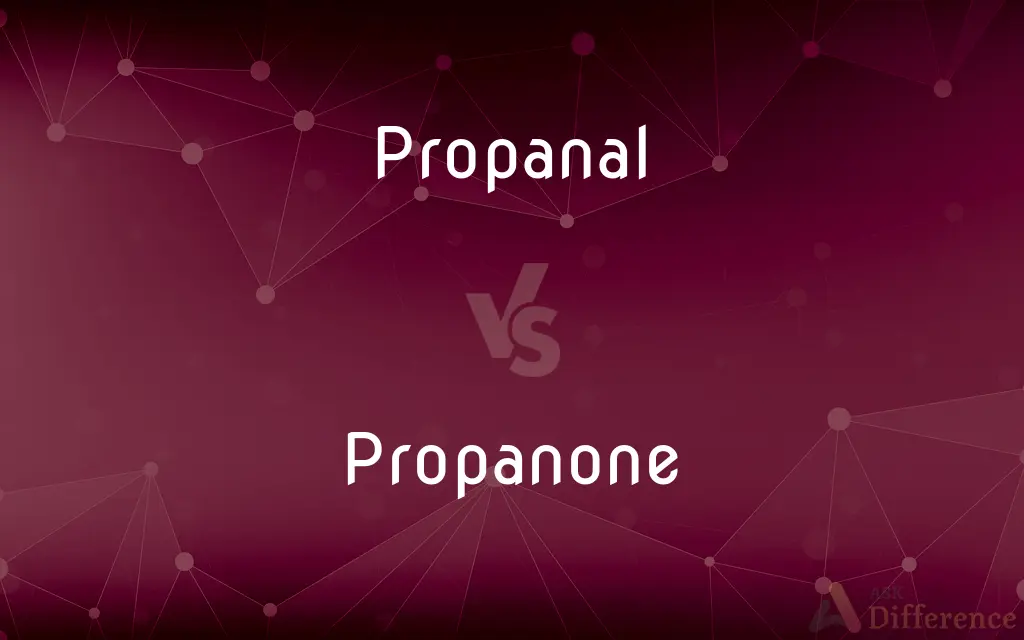Propanal vs. Propanone — What's the Difference?
By Tayyaba Rehman & Urooj Arif — Updated on April 18, 2024
Propanal is an aldehyde with a formula of C3H6O, characterized by a -CHO group, while propanone, also known as acetone, is a ketone with the same molecular formula but features a central carbonyl group (C=O).

Difference Between Propanal and Propanone
Table of Contents
ADVERTISEMENT
Key Differences
Propanal, also known as propionaldehyde, has a functional group of -CHO at the end of its carbon chain, making it an aldehyde. Whereas, propanone, commonly called acetone, has a carbonyl group (C=O) positioned at the center of the molecule, classifying it as a ketone.
The structural placement of the functional groups in propanal results in different chemical reactivities compared to propanone. Propanal is more likely to undergo nucleophilic addition reactions due to its terminal carbonyl group. On the other hand, propanone, with its carbonyl group flanked by two methyl groups, typically undergoes different types of reactions, like condensation.
In terms of physical properties, propanal has a boiling point of 48-50 °C and is slightly less volatile. Propanone, however, has a higher volatility and a boiling point of 56 °C, impacting its use and handling in industrial applications.
Propanal is often used in the manufacture of plastics, pharmaceuticals, and perfumes due to its ability to form larger molecules through polymerization. Propanone, meanwhile, is widely used as a solvent in the pharmaceutical, cosmetic, and plastic industries due to its excellent solvency properties.
In terms of toxicity and safety, propanal is considered more toxic and irritating to the mucous membranes compared to propanone. Propanone is generally regarded as safer and is a common component in household products like nail polish remover.
ADVERTISEMENT
Comparison Chart
Chemical Formula
C3H6O
C3H6O
Functional Group
Aldehyde group (-CHO)
Ketone group (C=O)
Boiling Point
48-50 °C
56 °C
Common Uses
Manufacturing plastics and pharmaceuticals
Solvent in cosmetics and industry
Reactivity
Prone to nucleophilic addition reactions
Participates in condensation reactions
Compare with Definitions
Propanal
More toxic compared to related compounds like propanone.
Handling propanal requires careful safety precautions due to its toxicity.
Propanone
Commonly used as nail polish remover and paint thinner.
Most households contain products with propanone for cleaning or cosmetic purposes.
Propanal
An organic compound with the molecular formula C3H6O, characterized by an aldehyde group.
Propanal is often used in synthetic applications due to its reactivity.
Propanone
Also known as acetone, a solvent with the formula C3H6O.
Propanone is used to dissolve various plastics and fibers.
Propanal
A colorless, flammable liquid with a pungent odor.
In the lab, propanal's sharp smell is immediately noticeable.
Propanone
A volatile, colorless liquid that evaporates quickly.
Propanone's rapid evaporation makes it ideal for quick-drying applications.
Propanal
Used in the production of other chemicals through polymerization.
Propanal reacts with itself to produce compounds useful in various industries.
Propanone
Less toxic and has a sweetish odor.
Propanone's lower toxicity makes it safer for use in homes.
Propanal
Found in many organic synthesis pathways.
Propanal is a key intermediate in the synthesis of certain alcohols.
Propanone
Important for its solvency properties in industry.
In labs, propanone is essential for cleaning glassware due to its effectiveness in dissolving organic residues.
Propanal
See propionaldehyde.
Propanone
(chemistry) The systematic name of the simplest ketone with formula C3H6O, usually called acetone.
Propanal
(organic compound) propionaldehyde
Propanone
The simplest ketone; a highly inflammable liquid widely used as an organic solvent and as material for making plastics
Propanal
A colorless liquid aldehyde
Common Curiosities
What is the boiling point of propanal and how does it compare to propanone?
Propanal has a boiling point of approximately 48-50 °C, whereas propanone boils at 56 °C, indicating that propanone is slightly more volatile.
Are both propanal and propanone water-soluble?
Yes, both compounds are soluble in water, which allows them to be used in a variety of water-based chemical applications.
What are the safety concerns associated with using propanone in household products?
Although propanone is less toxic than many solvents, it is highly flammable and can cause irritation if inhaled or if it comes into contact with the skin.
What are the primary industrial uses of propanal?
Propanal is primarily used in the synthesis of plastics, perfumes, and pharmaceuticals, owing to its ability to polymerize and form larger molecules.
What role does propanal play in the pharmaceutical industry?
Propanal is used as an intermediate in the synthesis of various pharmaceuticals, including certain antibiotics and other drug compounds.
Can both propanal and propanone be used in the food industry?
Propanone is sometimes used as a solvent in the processing of food flavors and extracts, while propanal is not typically used in food applications due to its stronger reactivity and toxicity.
What precautions should be taken when handling propanal?
Due to its toxicity and volatility, proper ventilation, protective clothing, and eye protection are essential when handling propanal.
What type of smell is associated with propanal and propanone?
Propanal has a pungent, sharp odor, while propanone has a distinctively sweet and more tolerable smell.
How are propanal and propanone typically produced in industrial settings?
Propanal is usually produced through the oxidation of propane or as a byproduct in the oxidation of other aldehydes. Propanone is commonly produced through the dehydrogenation of isopropanol.
What makes propanone a preferred choice for nail polish removers?
Propanone efficiently dissolves nail polish due to its excellent solvency and rapid evaporation, minimizing residue and stickiness.
How do propanal and propanone react with other chemicals?
Propanal can react through nucleophilic addition due to its aldehyde group, while propanone, having a ketone group, is prone to undergo condensation reactions.
Is propanone considered an environmentally hazardous material?
Propanone is volatile organic compound (VOC) and contributes to atmospheric photochemical reactions, but it is not classified as highly hazardous to the environment.
How do the evaporation rates of propanal and propanone compare?
Propanone has a higher evaporation rate compared to propanal, which makes it suitable for use in quick-drying solvents.
Can both propanal and propanone be detected through ordinary olfactory senses?
Yes, both can be detected by smell, which can serve as a practical indicator of their presence and concentration in the air.
What are the implications of the structural differences between propanal and propanone on their respective chemical properties?
The placement of the carbonyl group in propanone (central) versus propanal (terminal) significantly influences their chemical stability and reactivity, impacting how they are used in different chemical reactions and applications.
Share Your Discovery

Previous Comparison
Saxello vs. Saxophone
Next Comparison
Geocentric vs. HeliocentricAuthor Spotlight
Written by
Tayyaba RehmanTayyaba Rehman is a distinguished writer, currently serving as a primary contributor to askdifference.com. As a researcher in semantics and etymology, Tayyaba's passion for the complexity of languages and their distinctions has found a perfect home on the platform. Tayyaba delves into the intricacies of language, distinguishing between commonly confused words and phrases, thereby providing clarity for readers worldwide.
Co-written by
Urooj ArifUrooj is a skilled content writer at Ask Difference, known for her exceptional ability to simplify complex topics into engaging and informative content. With a passion for research and a flair for clear, concise writing, she consistently delivers articles that resonate with our diverse audience.














































